It was on display at Espace Mendès France (EMF) in Poitiers, France, in october-november 2015.
The work camouflages as a legitimate scientific exposé on an innovative spatial mission, "TRAXION",
destined to shed some light on a phenomenon that remains one of science's greatest mysteries : love.
Mixing actual scientific facts and absurd theories on human attraction presented in a serious fashion, the exhibit offers
real knowledge to visitors but also encourages them to maintain a critical eye and distinguish fact from fiction.
On display are two big color banners explaining the origins and details of the mission, as well as a display case containing
a model of a meteorite with an exploratory module attached to it. A button at the base of the case activates the module,
which starts probing/humping the meteorite (photo 2).
The meteorite seems randomly shaped, but the light above it reveals it has a heart-shaped shadow.
(Electro-magnetic mechanism conceived with David Dreano)
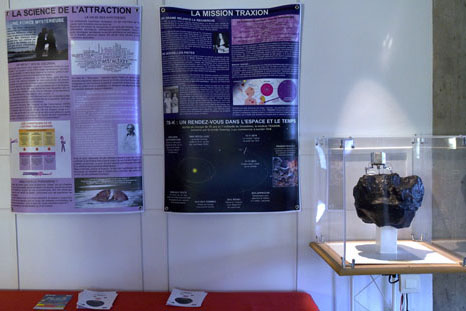
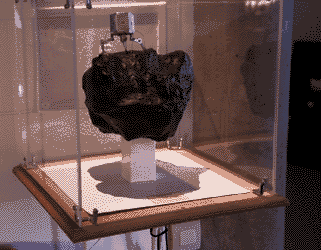
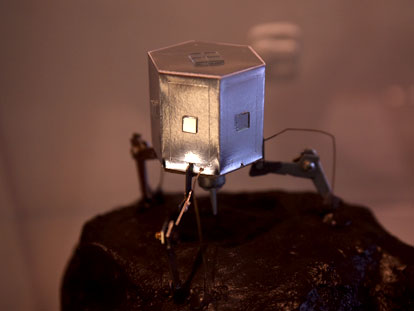
1: global view of the installation at EMF (2 banners, display case, table with brochures) / 2: activating the landing/probing module mecanism (animation) / 3: detail of the module.
Scientific data and sociological observations are absurdly mashed-up to explain the conception of mission TRAXION
(Theoretically Relevant Attraction X-ploration Investigating Orbiting Nucleus). Inspired by real-life space mission Rosetta,
this one is similarly about sending a capsule through space and time, but to explore (fictional) far-away comet 78-K
and bring back a sample of it to help researchers understand the origins of life... and of love.
CONTENTS
- 1: THE SCIENCE OF ATTRACTION -
A FORCE AS UNIVERSAL AS PROBLEMATIC
It is universal, timeless and blind to gender, race or age... but attraction between individuals, despite being at the heart of our lives and
celebrated by arts and media alike, still lacks satisfying scientific explanations.
What draws us to someone ? How do we choose our partners ?
Considering how irrational and detrimental (to personal well-being and to society) these choices can be, it seems long overdue that science
would seriously investigate the matter.
Because when the "chosen one" is uninterested, unaccessible, incompatible, or that time has taken its toll, the consequences
can be devastating for our health (mental and physical), social abilities and motivation. Why does a creature as knowledgeable
and evolved as Homo Sapiens allow iself to make these crucial choices based on a simple "feeling" ?
Despite its dramatic and costly repercussions (obsession, depression, self-hatred, unhealthy and anti-social behaviour,
sociopathic impulses, torn families, madness, self-mutilation, suicide, plastic surgery...), the scientific community seems to have
ignored this question, although other dangerous addictions (alcohol and drugs, gambling, the lottery...) are thoroughly researched.

Image : "The cost of irrational attraction" (French language)
In our freedom-obsessed society, it seems unconceivable that science would choose our partners for us, but it should at least try
to enlighten us - and especially the most fragile - on our dead-end attractions and help avoid the biggest mistakes.
Of course several studies have been published and theories discussed during the course of history, but most of these (psychological,
psychoanalytical or sociological) either were partial, biased to maintain social order, the male-heterosexual-cis domination and lazy
stereotypes, or were way too general and theoretical in the face of our chaotic behaviours.
Thankfully, an American researcher finally took the matter in his own hands, designing an original and ambitious mission : TRAXION.
WHEN DRAMA FUELS RESEARCH
In June 1995, Dr. Huey B. Downey, head neurobiologist at Salk Institute for Biological Studies (La Jolla, CA), famous for his cerebral mapping work,
visits Igor Sikorsky Kyiv Polytechnic Institute in Kiev (Ukraine) and falls hard for a 20-year old singer heard singing in a bar : Elena Tkachuk (photo).
Despite being 35 years older than her and married with two children, Downey grows obsessed with the young woman, quitting his job and
abandoning his family to follow her on tour, despite not knowing a thing about her and not being able to pronounce her name. After a year of this
obsession (a chronicle of which was compiled from his Ukrainian journals under the title Traces Of Elena, Fountain Pen Publishing, 2002), broke and
unable to communicate with this woman, he starts self-mutilating, removing the last two letters of his surname. He eventually throws himself and drowns
in the river Desna in November 1996. His tombstone at Kiev's Lukianivske cemetery reads "To E.T., forever - Huey B. Down".
Downey's long-time assistant back home, Dr. Martin J. Portnam, devastated and furious, thus decides to devote his career to scientifically examining
why passion makes people act so irrationally. Close witness to Downey's downfall through numerous letters his friend and mentor sent him, he starts drawing
analogies between Downey's inability to objectively analyze his situation and the uncertain behaviour of particles within quantum physics, which also defy
"classical" logic : an object can be at two places or in two different states at the same time, and can interact with another even if they are very distant.
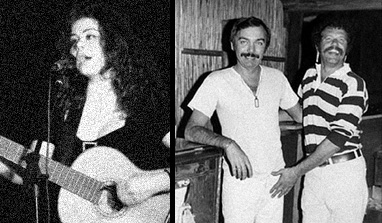
Photos : Elena Tkachuk in 1995 (photo : Huey B. Downey) / Downey and Portnam, San Diego, 1969 (photo © Lambda Archives Of San Diego)
- 2: QUANTUM RESEARCH - THE TRAXION MISSION"
FROM QUANTUM PHYSICS TO QUANTUM LOGIC
Dr. Portnam starts searching for a possibly fundamental and invisible physical process that modifies brain activity, far beyond psychology.
Recalling his nights out in San Diego with Dr. Downey, Portman is struck by the concept and image of the glitterball, its reflections throwing
a moving constellation of light rays on the dancers. This sets him on a thorough exploration of neutrinos : sub-atomic and omnipresent
elementary particles, 50 billion of which (from the sun) pass through our bodies every single second !
Part of the Big Bang cosmic residue and gliding through us all, neutrinos are a direct link to the birth of the universe. Their mass is close to zero,
their charge is neutral and their collisions with atoms very rare, making their influence on us highly unlikely. But Portnam's determination,
embracing Quantum Logic, would not be stopped by true/false scenarios. Looking for a unifying concept, Portnam relates the subatomic
(quantum particles, quarks...) and the cosmologic (stars, galaxies, dark energy...). Big Bang particles are still flying around, some of them trapped
in comets, and their exploration could help us taste the famous "primordial soup" which gave birth to everything, allowing us to look 13.8 billion
years back into our origins, and possibly the source/cause of our ill-advised sentimental misdemeanors.
Portnam explained his theory in an ambitious 600+ page book, In & Out of Ourselves: Unification of Particle Interaction Through Space and Time,
which earned him admiration and perplexity in equal amounts but was highly instrumental in rallying funds for his work.
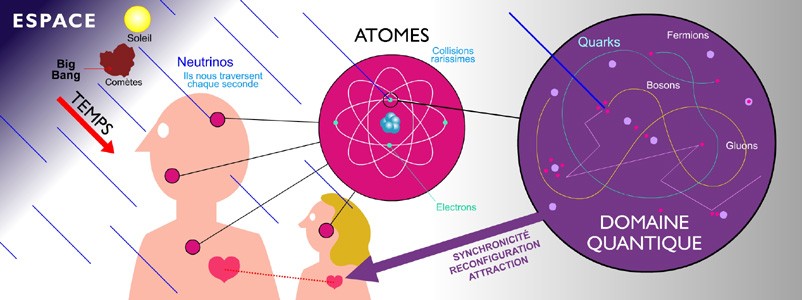
Image from In & Out of Ourselves: Unification of Particle Interaction Through Space and Time - M. J. Portnam (Blue Cheer, 2002)
THE TRAXION MISSION
While working on his book, Portnam had spotted a small comet, 78-K, not too far away and with a gravitational pull perfect for a probe to land on.
As he started planning a mission to explore it, he renamed it "Elena", a nod to his colleague Downey's fate. A probe, "Downey", would be sent
along with an exploration module (TRAXION - Theoretically Relevant Attraction X-ploration Investigating Orbiting Nucleus) on Elena.
Launched in 2004, it successfully landed on 78-K on October 15th 2014, with first results confirming its varying mineral composition, reporting traces of
an organic composite crust around it, and possibly the presence of microorganisms below its rocky/icy surface. The samples and observations collected
by TRAXION are currently being examined by a conglomerate of scientists led by Dr Portnam at Salk Institute, despite protests held by representatives
of various corporations (jewellers, flower/gift shops, fiction writers, figurative artists...), who oppose the idea of demystifying "love".
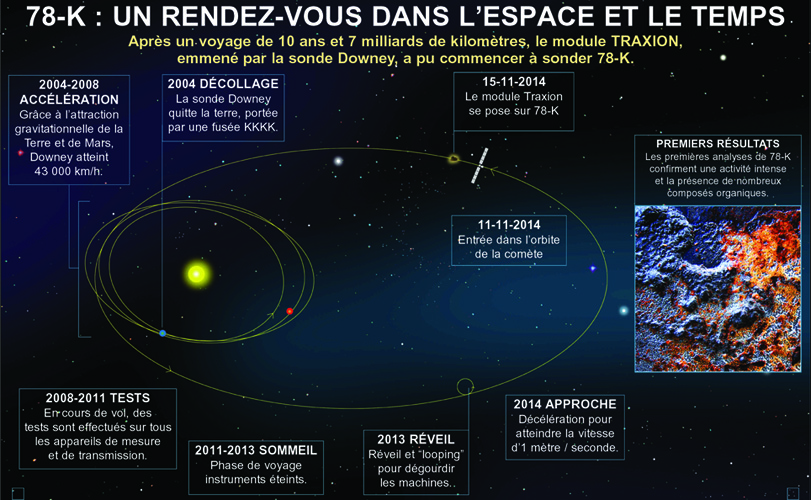
Image recapitulating the 10-year and 7 billion kilometer trip of "Downey" and TRAXION module towards "Elena". (French language)
EXHIBIT RECEPTION
Perfectly integrated within Espace Mendès France in a spot where there are usually "regular" scientific exhibits, and with no obvious sign
saying "ART" above it, the TRAXION installation exceeded expectations in the Camouflage Art domain : many visitors did not question
the veracity of the presentation at all, while others who had come looking for some "art on display" said they could not find it.
All in all it was a "quantum achievement", blurring the lines between success and failure.
- back -